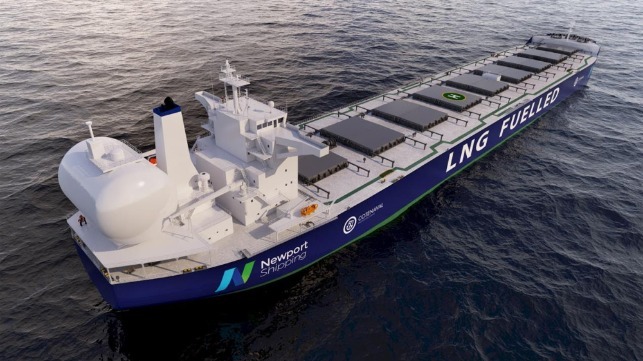Tank Design for LNG Conversion of Existing Ships Receives DNV AiP

A new design concept to permit the conversion of crude oil tankers and bulkers to operate on LNG gained a key preliminary class approval, providing shipowners a near-term path to meet pending fuel regulations and the growing market pressures to reduce emissions. While so far only a few ships have been retrofitted to use LNG, UK-based Newport Shipping believes its concept can provide a cost-effective solution to make LNG retrofits more financially attractive.
Newport Shipping’s concept is based on deck-mounted LNG tanks that can be installed without major modifications to the vessel’s hull. Tank capacity, which is based on a typical ship profile and operating route, would be sufficient for a single voyage before refueling. The innovative fuel tank system, installed as part of a retrofit solution using a dual-fuel engine, reduces the installation costs. The system would also be suitable for carbon-neutral methane, such as bio-LNG, when these fuels become available in the future.
According to Newport, the approval-in-principle (AIP) from the DNV affirms the technical feasibility of the concept for the VLCC and Capesize vessel classes. It also paves the way for the fuel tank system to be implemented in design work on retrofits by the UK-based ship repair and retrofitting group.
Lianghui Xia, managing director of Newport Shipping believes the concept offers “a practical and cost-efficient solution” to cut fleet emissions in the near-term pending adoption of technologies for carbon-neutral fuels such as ammonia and hydrogen, as well as battery technology,” all of which he points out are still a few years away from commercial application.
With an existing global fleet of approximately 100,000 vessels, one of the challenges the shipping industry faces is a near-term solution to reducing emissions for ships in operation today. Shipping companies have been weighing the financial alternatives and operating considerations between the use of low-sulfur fuels or emerging alternative biofuels, the installation of scrubbers, or other retrofits.
Only a handful of companies has undertaken the conversion of existing ships to LNG. One of the higher-profile early adopters was Hapag-Lloyd, which recently undertook the conversion of the 15,000 TEU containership Sajir to LNG-fueled propulsion. While the vessel was designed for the conversion to LNG, Hapag’s CEO Rolf Habben Jansen said the costs at an estimated $35 million were prohibitive and would not make economic sense for additional conversions unless the cost could be lowered by as much as 25 percent.
Newport believes that its fuel tank system addresses the cost concerns both with the lower installation cost and the lower fuel costs of LNG compared to other transitional solutions. Lianghui Xia points out that CO2 emissions can be reduced by between 20 and 30 percent just by switching to LNG without installing any other equipment.
Conversion of existing ships to the use of LNG Newport says also provides shipowners an advantage with charters and banks which are increasingly making decarbonization a condition of cargo contracts and ship finance. Newport plans to also support shipowners undertaking the conversion, offering a long-term payment plan over five to seven years on 60 percent of the total cost to enhance the financial case for its LNG retrofit solution.
